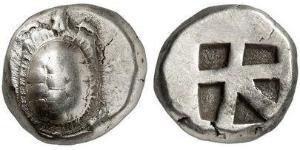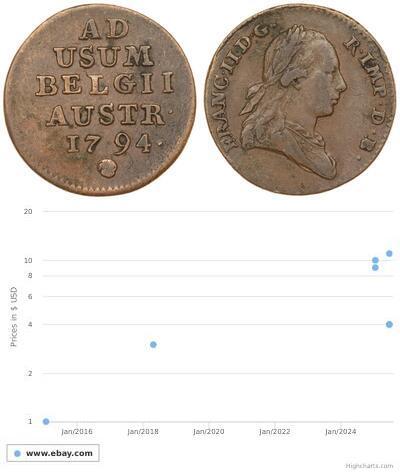1 Stater Ancient Greece (1100BC-330) Silver
Ancient Greece, Aspendos, Pamphylia (420-370 BC) Silver Stater Coin.
Denomination: AR Stater
Mint Period: 420-370 BC
Reference: SNG Paris 73, SNG von Aulock 4506.
Mint Place: Aspendos, Pamphylia (Antalya province in today´s Turkey)
Weight: 10.89gm
Diameter: 23mm
Material: Silver
Obverse: Two nude wrestlers grappling each other. All within round dotted border.
Reverse: Slinger striding to right, pulling sling taut over head. Triskelion in right field, vertical inscription (EΣTFE) in left field. All wihtin square dotted border.
A triskelion or triskeles is an ancient motif consisting of a triple spiral exhibiting rotational symmetry or other patterns in triplicate that emanate from a common center. The spiral design can be based on interlocking Archimedean spirals, or represent three bent human legs. It is found in artifacts of the European Neolithic and Bronze Age with continuation into the Iron Age especially in the context of the La Tène culture and related Celtic traditions. The actual triskeles symbol of three human legs is found especially in Greek antiquity, beginning in archaic pottery and continued in coinage of the classical period.
In the Hellenistic period, the symbol becomes associated with the island of Sicily, appearing on coins minted under Dionysius I of Syracuse beginning in c. 382 BCE. It later appears in heraldry, and, other than in the flag of Sicily, came to be used in the flag of the Isle of Man (known as ny tree cassyn ‘the three legs’).
Greek τρισκελής (triskelḗs) means ‘three-legged’. While the Greek adjective τρισκελής ‘three-legged (e.g., of a table)’ is ancient, use of the term for the symbol is modern, introduced in 1835 by Honoré Théodoric d’Albert de Luynes as French triskèle, and adopted in the spelling triskeles following Otto Olshausen (1886). The form triskelion (as it were Greek τρισκέλιον) is a diminutive which entered English usage in numismatics in the late 19th century. The form consisting of three human legs (as opposed to the triple spiral) has also been called a “triquetra of legs”, also triskelos or triskel.
Aspendos or Aspendus (Pamphylian: ΕΣΤϜΕΔΥΣ; Attic: Ἄσπενδος) was an ancient Greco-Roman city in Antalya province of Turkey. The site is located 40 km east of the modern city of Antalya. It was situated on the Eurymedon River about 16 km inland from the Mediterranean Sea; it shared a border with, and was hostile to, the ancient city of Side.
The wide range of its coinage throughout the ancient world indicates that, in the 5th century BC, Aspendos had become the most important city in Pamphylia. At that time, according to Thucydides, the Eurymedon River was navigable as far as Aspendos, and the city derived great wealth from a trade in salt, oil and wool.
Aspendos did not play an important role in antiquity as a political force. Its political history during the colonisation period corresponded to the currents of the Pamphylian region. Within this trend, after the colonial period, it remained for a time under Lycian hegemony.[citation needed] In 546 BC, it came under Persian domination. The fact that the city continued to mint coins in its own name, however, indicates that it had a great deal of freedom even under the Persians.
Circa 465 BC, Cimon led an Athenian navy against a Persian navy in the Battle of the Eurymedon, and destroyed it. Aspendos then became a member of the Delian League.
The Persians captured the city again in 411 BC and used it as a base. In 389 BC, Thrasybulus of Athens, in an effort to regain some of the prestige that city had lost in the Peloponnesian Wars, anchored off the coast of Aspendos in an effort to secure its surrender. Hoping to avoid a new war, the people of Aspendos collected money among themselves and gave it to the commander, entreating him to retreat without causing any damage. Even though he took the money, he had his men trample all the crops in the fields. Enraged, the Aspendians stabbed and killed Thrasybulus in his tent.
When Alexander the Great marched into Aspendos in 333 BC after capturing Perge, the citizens sent envoys asking him not to garrison soldiers there. He agreed, provided he would be given the taxes and horses that they had formerly paid as tribute to the Persian king.[citation needed] After reaching this agreement Alexander went to Side, leaving a garrison there on the city’s surrender. Going back through Sillyon, he learned that the Aspendians had failed to ratify the agreement their envoys had proposed and were preparing to defend themselves. Alexander marched to the city immediately. When they saw Alexander returning with his troops, the Aspendians, who had retreated to their Acropolis, again sent envoys to sue for peace. This time, however, they had to agree to very harsh terms; a Macedonian garrison would remain in the city and 100 gold talents as well as 4,000 horses would be given in tax annually.
In 190 BC, the city surrendered to the Romans, and the corrupt magistrate Verres later pillaged its art treasures. It was ranked by Philostratus the third city of Pamphylia, and in Byzantine times seems to have been known as Primopolis. Toward the end of the Roman period the city began a decline that continued throughout Byzantine times, although in medieval times it was evidently still a strong place.
Diogenes Laërtius writes that there was a native of Aspendos called Demetrius, who was a pupil of Apollonius of Soli. In addition, he mentions Diodorus of Aspendus.
View all coins in the group
(1200 X 593 pixels, file size: ~236K)
Posted by: anonymous 2016-12-04
Ancient coins Greece. Pamphylia, Aspendos, Stater 370-342 BC NGC AU Aw.: Dwaj nadzy, walczący zapaśnicy.Rw.: Procarz w prawo w kwadratowej ramce.Moneta w gradingu amerykańskiej firmy NGC.Ładny egzemplarz. Bardzo dobre detale. Waga/Weight: , Metal: Ag, Średnica/diameter: 22-24 mm, Stan zachowani ...
(3205 X 1559 pixels, file size: ~676K)
Posted by: anonymous 2023-11-04
Ancient Greece, Aspendos, Pamphylia (420-370 BC) Silver Stater Coin. NGC VF 4/5! Denomination: AR Stater Mint Period: 420-370 BC Reference: SNG Paris 73, SNG von Aulock 4506. Condition: Certified and graded by NGC as VF 4/5, 5/5! Mint Place: Aspendos, Pamphylia (Antalya provi ...
(795 X 453 pixels, file size: ~137K)
Posted by: anonymous 2015-12-25
Aspendos AR Stater, c. 380-325 BC Aspendos, Pamphylia. AR Stater (22-25 mm, 10.81 g), c. 380-325 BC. Obv. Two wrestlers; between them, LΦ. Rev. EΣTFEΔIIY, slinger to right, triskeles in right field. Tekin Series D; SNG von Aulock 4565. Areas of flatness, otherwise, very fine. Ex CNG EA 143 (200 ...
(800 X 365 pixels, file size: ~108K)
Posted by: anonymous 2015-09-03
Pamphylia, Aspendos (c.380-325 BC), AR Stater, 10.52g, two wrestlers grappling, Pamphylian letters between them, rev. etfeiiy (Pamphylian script), slinger standing right, wearing short chiton, loosing shot, triskeles to right, all within dotted linear square (SNG France 99-100; BMC 41), very fine
(800 X 431 pixels, file size: ~135K)
Posted by: anonymous 2015-09-03
x Pamphylia, Aspendos (c.330/25-300/250 BC), AR Stater 10.59g, two wrestlers, o between, rev. inscription behind standing slinger, forepart of horse in field to right above lyre (SNG France 113), very fine
(1200 X 618 pixels, file size: ~250K)
Posted by: anonymous 2015-10-08
Pamphylia. Aspendos. Ar Stater, c. 420-370 (Ar - 10,94g - 22mm - 4h). SNG BN 47-51 var., SNG Copenhagen 180-185 var. Interesting ancient countermark. Very fine.
|
1 Liard Belgium Copper
group has 4 coins / 4 prices
⇑

-500-250-igYKbzbi6QkAAAFLNg36Agfa.jpg)
-300-150-sjsKX9ISFlMAAAFYUba668hS.jpg)
-300-150-le7PZvesAWoAAAGLwCN6lZfv.jpg)
-300-150-YWcKbzbifhwAAAFREB6WytaD.jpg)
-300-150-UMEKbzbiQiIAAAFPkteA8JEO.jpg)
-300-150-sNUKbzbi2rMAAAFPmCmA8JEr.jpg)
-300-150-BCUKbzbiyJYAAAFQ99zkrkUE.jpg)














